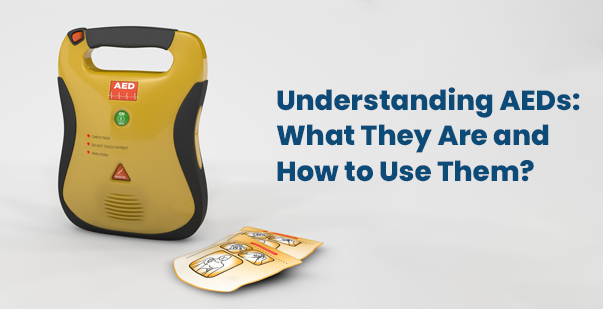Have you ever heard of an AED before? AED stands for “automated external defibrillator,” and it’s a special device that can help save someone’s life. But, how does it work? When should you use it? In this blog, we’ll talk all about AEDs – what they are, how they work, what are the steps to use AED and how you can use them.
It’s important to know about AEDs because you never know when you might need to use one to help someone in an emergency. You can learn how to use an AED by enrolling in the online CPR AED course by American HealthCare Academy. This course is 100% online. It is led by experts and is valid for 2 years. Get in touch with us today!
Overview of AEDs
An AED is a life-saving device that can help someone who is having a sudden cardiac arrest. It’s a small, portable device that can be found in many public places, like schools, malls, airports, and even in some police cars and ambulances.
The AED machine works by sending an electric shock to the heart to try and restore its normal rhythm. The device is very easy to use – it has step-by-step instructions that will guide you through the process.
AEDs are designed to be used by anyone, even if you don’t have medical training. When you turn on the AED, it will give you clear and simple voice prompts to help you through the process. It will tell you exactly what to do, like where to place the pads on the person’s chest and when to press the shock button.
AEDs are not just for adults – they can also be used on children and infants, but you may need to use special pads that are designed for smaller bodies.
Steps to use AED for saving lives
What are different types of AEDs?
There are different types of AEDs available in the market. Some AEDs are designed for use by trained medical professionals, while others are designed to be used by anyone, even if you don’t have medical training. The two basic types of AEDs are:
Fully automatic AED
This type of AED is very easy to use – all you need to do is turn it on and follow the voice prompts. The AED will analyze the person’s heart rhythm and, if necessary, deliver a shock automatically. You don’t need to press any buttons or do anything else – the AED will do everything for you.
Semi-automatic AED
This type of AED also gives you voice prompts, but you may need to press a button to deliver the shock. The AED will still analyze the person’s heart rhythm and tell you when to press the button, so you don’t need to worry about the process.
– Some AEDs are designed for use in specific settings, like on airplanes or in hospitals. These AEDs may have different features or settings that are tailored to the specific environment.
Steps to use AEDs properly on a CPR patient
Here are the steps to use AED on a CPR patient:
- Turn on the AED – most AEDs will turn on automatically when you open it.
- Expose the person’s chest – remove any clothing or jewelry that might interfere with the pads.
- Attach the pads to the person’s chest – follow the instructions on the pads and place them on the person’s bare skin. One pad goes on the upper right side of the chest and the other pad goes on the lower left side of the chest.
- Analyze the heart rhythm – once the pads are attached, the AED will analyze the person’s heart rhythm and determine if a shock is needed.
- If a shock is advised – the AED will tell you to press the shock button. Make sure that no one is in contact with the patient when you deliver the shock.
- Start with chest compressions – after the shock is delivered, the AED will instruct you to resume CPR. Follow the instructions and continue until emergency help arrives. For the emergency to arrive, you need to call 911 first. Let them know the correct scenario in front of you. Chances are that even the medical emergency team might guide on the phone until they arrive. So you will also panic less.
- Follow the AED prompts – the AED will continue to give you voice prompts throughout the process. Follow them carefully, and do not hesitate to ask for help if you’re unsure what to do next.
Conclusion
If someone is unresponsive and not breathing normally, it’s important to call for emergency help right away and start CPR. If there is an AED available, it can be used in addition to CPR to help increase the person’s chances of survival. So, don’t be a bystander anymore. Be proactive and save a life!













